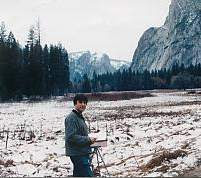
The "picture plane" is an interesting thing. As a continuation of the last Blog, I wanted to point out the fact that accurate drawing is exactly like looking through a piece of glass. In reality this is what a camera does. Yes, cameras with cheap lenses do "distort" the image a little. A quality lens will shoot "flat" or undistorted images. It's not worth worrying about for most of us though, but I mention it. In the old days the image was produced literally on a glass plate. As I pointed out, this image is perpendicular to wherever the camera is pointed, exactly like one's eye.
I think anyone familiar with books on "How to Draw" have seen the etching or block print of an artist looking through some sort eyepiece and then a string gridded frame. Before them on the table is a paper with a proportional grid drawn on it. This is grid devise is a way to get the picture plane and the "drawing plane" to be exactly the same. Today we could put a piece of glass before us with an eye piece in front of us to look through. The eye piece is to make sure we are always looking from the same spot. We could then draw the scene before us onto the glass using a marker. The resulting drawing would have perfect perspective. In essence, this is the goal we are trying to achieve without the bulk of such a devise or by using a camera. Yes, projecting an image from a camera will result in the same thing, provided the lens shoots "flat". For my money a camera is nothing but a nuisance. Cameras, projectors, and drawing frames all have their place but I'd rather go for the speed and convenience of being myself, an expert at draftsmanship. Why mess with the rest when you can learn to draw it in seconds or minutes and be very accurate. What ease, what Fun!
I spent a long time in the last post trying to pass along the importance of getting your paper of canvas in exactly the right position to work at. There is nothing as sad as working on a portrait for an hour or two while it lays flat on a table in front of you. You finally are positive you have it right and then you lift it up and "Ugh" ,the face is too darn long and skinny. This is what results by having the drawing in a tilted plane to the eye.
I wanted to point out a really weird thing done by a few artists in the past where they used this effect for purpose. You may happen upon one of these weird paintings in a museum someday. They look like some sort of normal painting with a weird looking blur diagonal across the work. "Why?" you ask. Well they are designed for the viewer to walk up to the corner of the painting and then look glancing-ly across the piece. What they will see is an image that they couldn't make out from the normal view. This "blur" is in reality, an image set down from a very close perceptive. These paintings are known as "Anamorphosis" paintings and were done by such artists as Hans Holbein the Younger. One could easily get the same effect today by projecting an image across their canvas from a very close position and at an angle. Another thing that is similar in our world are letters on the road. When we drive along and see the word "Stop" painted on the road, they are very stretched out but don't appear that way when we see them. If you actually stop to look at the letters, they are 4 times longer than they are wide. In some cases they are 8 times longer. This is an "exaggerated" perspective drawing but is exactly what happens, to a lesser degree, when an artist doesn't properly align their work to their eye. .....link to last post HERE
I should add that there are artists still making art using "anamorphosis" effects and a simple web search will show that.

No comments:
Post a Comment